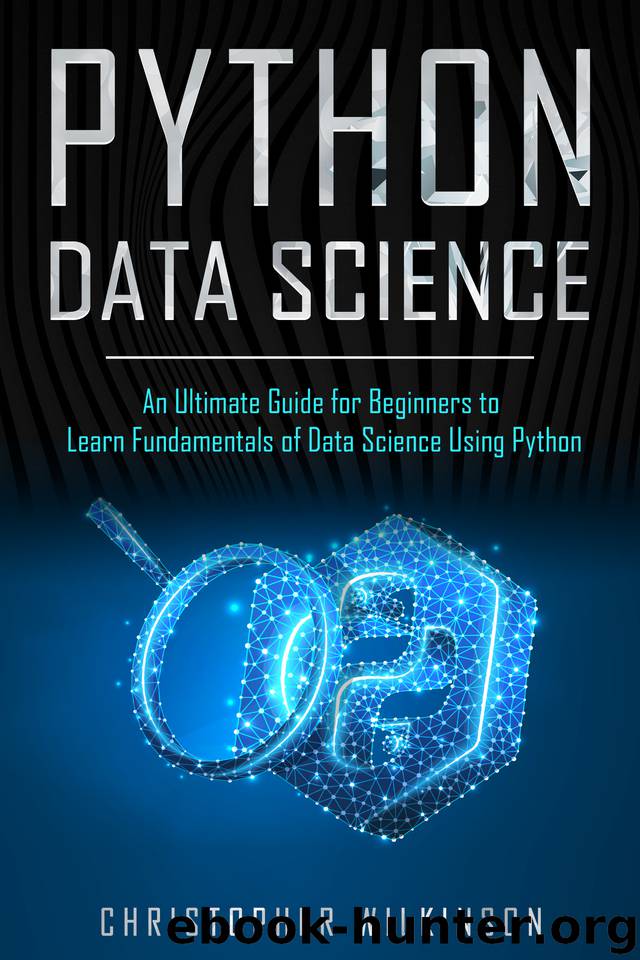Python Data Science: An Ultimate Guide for Beginners to Learn Fundamentals of Data Science Using Python by Wilkinson Christopher

Author:Wilkinson, Christopher [Wilkinson, Christopher]
Language: eng
Format: epub
Published: 2019-10-25T16:00:00+00:00
Chapter 7: Python Data Science Libraries and General Libraries
In the previous chapters, we discussed the important concepts of Python, such as data structures, built-in functions, variable, exceptions, methods, for loops and if statements. Now, we will study the modules and packages of Python that is important for any project.
Python programming and data science are integral to one another. Python is an unbelievable language for data science and the individuals who need to begin in the field of data science. It bolsters countless cluster libraries and systems to give a decision for working with data science in a spotless and productive manner. The different systems and libraries accompany a particular reason for use, and should be picked by your prerequisite.
7.1 Python Data Science Libraries
A Python library is a gathering of capacities and techniques that aid in finishing explicit assignments. There are highly advanced libraries employed by developers for various tasks. In the beginning, Data Science and Python was considered unsuitable for each other, and now Python is very much connected with statistics, machine learning, and predictive analytics, as well as simple data analytics tasks. It is getting more accessible and useful day-by-day, as it is an open-source language. There are millions of data scientists who are enriching the language with tools through advanced coding. Now, there are highly advanced packages and libraries that data scientists are using for multiple data analysis tasks.
A brief description of some of the best Python libraries is given below
Numpy
NumPy is a very crucial Python library implied for logical registering. It accompanies support for an amazing N-dimensional exhibit item and broadcasting capacities.
Additionally, NumPy offers Fourier changes, arbitrary number capacities, and devices for coordinating C/C++ and Fortran code. Having a working understanding of NumPy is obligatory for full stack developers associated with AI ventures utilizing Python.
Numpy is the most fundamental, and a fantastic bundle, for working with information in Python. On the off chance that you are getting down to business on information investigation or Machine learning ventures, at that point, having a strong comprehension of numpy is required.
Different bundles for information investigation (like pandas) is based on numpy and the scikit-learn package that is utilized to assemble AI applications.
What does numpy provide?
At the center, numpy gives the phenomenal ndarray objects; short for n-dimensional clusters. In a 'ndarray' object, otherwise known as 'exhibit', you can store numerous things of similar information. It is the offices around the exhibit object that makes numpy advantageous for performing math and information controls.
Salient Features
· It is a very interactive library and it’s easy to use.
· Mathematical problems are solved with ease.
Pandas
In Python, we use two-dimensional tables to analyze data, like in SQL or Excel. Initially, Python didn't have this feature. But that's why Pandas is so famous. Without a doubt, Pandas is the "SQL of Python. " In short, Pandas is the library that will help us to handle two-dimensional data tables in Python. In many ways, it's similar to SQL, though.
The Pandas' library is not exclusively a focal segment of the information science toolbox, yet it is utilized for different libraries in that accumulation.
Download
This site does not store any files on its server. We only index and link to content provided by other sites. Please contact the content providers to delete copyright contents if any and email us, we'll remove relevant links or contents immediately.
Algorithms of the Intelligent Web by Haralambos Marmanis;Dmitry Babenko(8519)
Azure Data and AI Architect Handbook by Olivier Mertens & Breght Van Baelen(7306)
Building Statistical Models in Python by Huy Hoang Nguyen & Paul N Adams & Stuart J Miller(7301)
Serverless Machine Learning with Amazon Redshift ML by Debu Panda & Phil Bates & Bhanu Pittampally & Sumeet Joshi(7188)
Data Wrangling on AWS by Navnit Shukla | Sankar M | Sam Palani(6950)
Driving Data Quality with Data Contracts by Andrew Jones(6937)
Machine Learning Model Serving Patterns and Best Practices by Md Johirul Islam(6674)
Learning SQL by Alan Beaulieu(6152)
Weapons of Math Destruction by Cathy O'Neil(6077)
Big Data Analysis with Python by Ivan Marin(5693)
Data Engineering with dbt by Roberto Zagni(4687)
Solidity Programming Essentials by Ritesh Modi(4349)
Time Series Analysis with Python Cookbook by Tarek A. Atwan(4187)
Pandas Cookbook by Theodore Petrou(3908)
Blockchain Basics by Daniel Drescher(3422)
Hands-On Machine Learning for Algorithmic Trading by Stefan Jansen(2959)
Natural Language Processing with Java Cookbook by Richard M. Reese(2916)
Feature Store for Machine Learning by Jayanth Kumar M J(2858)
Learn T-SQL Querying by Pam Lahoud & Pedro Lopes(2844)
